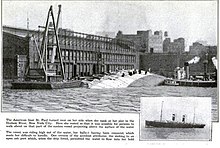St. Paul (ship, 1895)
|
||||||||||||||||||||||
|
||||||||||||||||||||||
|
||||||||||||||||||||||
|
||||||||||||||||||||||
The St. Paul was a passenger ship of the American shipping company American Line , which was put into service in 1895 and was built for transatlantic passenger and mail traffic between Europe and the USA . At that time she was one of the largest passenger ships under the American flag. During the First World War she served as the USS St. Paul (SP-1643) as a troop transport . After the end of the war, it was back in passenger traffic from 1919 until it was scrapped in Germany in 1923 .
The ship
The 11,629 gross register tons, steel- built steamship was built at the William Cramp and Sons shipyard in Philadelphia and was launched there on April 10, 1895. The ship was 168.61 meters long and 19 meters wide and had two masts , two funnels and two propellers . The cruising speed was 19 knots. The passenger accommodation was designed for 350 passengers in the first, 220 in the second and 800 in the third class. The St. Paul was the sister ship of the St. Louis (also 11,629 GRT), which had been launched six months earlier at the same shipyard.
They were the largest ships of their shipping company until then and were among the largest ocean liners in the United States. The owner was the International Navigation Company , but both ships were operated by the American Line . On October 9, 1895, put St. Paul in New York for its maiden voyage to Southampton from (England).
On April 24, 1908, the St. Paul collided in the Solent with the HMS Gladiator , a protected cruiser of the Royal Navy . The HMS Gladiator capsized about 200 meters from shore and sank, killing 28 of its 257 men.
War missions
In 1898 the steamer was temporarily used by the United States Navy as an auxiliary cruiser in the Spanish-American War . The ship was armed with multiple cannons and entered service on April 20, 1898 under the command of Captain Charles Dwight Sigsbee (better known as the Commander of the Maine ). On May 5, 1898, the St. Paul set out for the Caribbean . On June 22, 1898, the ship was fired upon by the Spanish destroyers Isabel II and Terror during the Second Battle of San Juan . The St. Paul returned fire and was able to deal a direct hit with the terror , whereby the destroyer was badly damaged and the battle broke off. Four days later, St. Paul received reinforcements from the Yosemite . On September 2, 1898, the ship was released from military service and returned to its shipping company.
When she arrived in New York on September 2, 1915, the St. Paul had both survivors of the sinking of the Lusitania (May 7, 1915) and the Arabic (August 19, 1915) on board. On September 30, 1915, more Lusitania survivors disembarked the St. Paul in New York .

On October 27, 1917, after a successful career as an ocean liner in the North Atlantic , the St. Paul was drafted again for military service and used as a troop transport by the United States Shipping Board with the registration number SP-1643 . In this role she made twelve crossings between New York and Liverpool . On April 28, 1918 , she capsized during an overhaul in dry dock in New York. She was lifted on September 11, 1918 and transferred to the New York Naval Shipyard the next day . The First World War ended shortly afterwards .
On March 24, 1919, the St. Paul was returned to its owners and then reintegrated into transatlantic passenger traffic. In 1923 it was finally scrapped in Germany.

